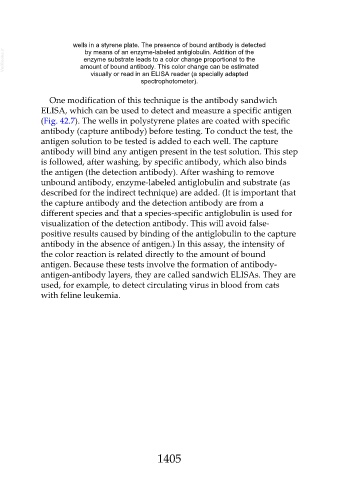Page 1405 - Veterinary Immunology, 10th Edition
P. 1405
wells in a styrene plate. The presence of bound antibody is detected
VetBooks.ir amount of bound antibody. This color change can be estimated
by means of an enzyme-labeled antiglobulin. Addition of the
enzyme substrate leads to a color change proportional to the
visually or read in an ELISA reader (a specially adapted
spectrophotometer).
One modification of this technique is the antibody sandwich
ELISA, which can be used to detect and measure a specific antigen
(Fig. 42.7). The wells in polystyrene plates are coated with specific
antibody (capture antibody) before testing. To conduct the test, the
antigen solution to be tested is added to each well. The capture
antibody will bind any antigen present in the test solution. This step
is followed, after washing, by specific antibody, which also binds
the antigen (the detection antibody). After washing to remove
unbound antibody, enzyme-labeled antiglobulin and substrate (as
described for the indirect technique) are added. (It is important that
the capture antibody and the detection antibody are from a
different species and that a species-specific antiglobulin is used for
visualization of the detection antibody. This will avoid false-
positive results caused by binding of the antiglobulin to the capture
antibody in the absence of antigen.) In this assay, the intensity of
the color reaction is related directly to the amount of bound
antigen. Because these tests involve the formation of antibody-
antigen-antibody layers, they are called sandwich ELISAs. They are
used, for example, to detect circulating virus in blood from cats
with feline leukemia.
1405

